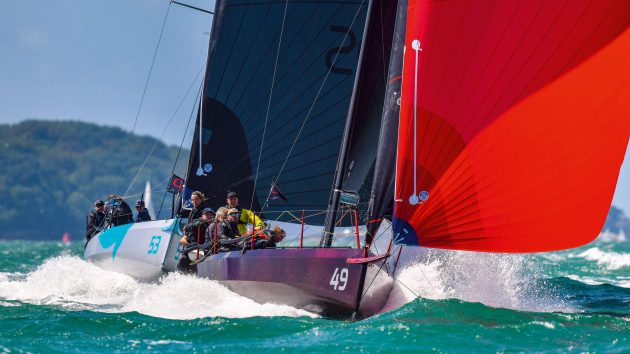If you want to sail downwind in big breeze it's important to know how hard you can push. And how can you stay in control? Pro skipper Jelmer van Beek shares top tips with Andy Rice
Pushing a boat close to the edge downwind is exhilarating and sometimes exhausting. Sailing hard downwind in waves requires 100% focus from the helmsman and trimmers, not to mention the grinders and other key members of the crew. One mistake and the gennaker can flap or, even worse, you end up broaching.
So how do you keep pushing the boat up to the edge without reaching the point of no return? As the person with direct control and feedback from the rudder, the helmsman has ultimate responsibility. But seeing as the rudder is only one part of the equation in achieving a fast, balanced boat, it’s also up to the helmsman to communicate what he’s feeling to the rest of the crew.
Here are Jelmer van Beek’s five best tips for pushing a boat hard, fast and to the edge when you sail downwind.
Crew weight
Have the crew as far outboard and as far aft as possible. It gives you more control over the rudder and helps keep the bow out of the water. It makes a big difference to the helmsman’s control over the boat.
If a job needs doing to leeward or forward, try to make sure it’s only one person getting off the rail. If you’ve still got 20 minutes of sailing before the next manoeuvre, it doesn’t make sense to have everyone running around doing their own jobs.
Dedicate one person to tidying the sheets for the trimmer, or going down below to fetch something that another team member needs. Maximum righting moment is super-important, even on a big boat where
it might feel like you’re not making that much difference.

Photo: ROLEX/Stefano Gattini
Work the vang
One person should be watching to windward all the time, calling in the gusts and the lulls so the rest of the crew can adjust the power. This might be the tactician, but it’s sometimes a good job for the pit to do. You also need one person on the vang all the time. It’s really good to have someone pull on the vang and tighten the leech in the lulls, and it’s really, really good to have them dump the vang when a big gust hits to help keep the boat on its feet and avoid a broach.
Curl the gennaker
Aim to keep some curl in the gennaker luff, or whichever downwind headsail you’re using. Oversheeting the kite makes it harder for the helmsman to steer the boat. When you curl the luff, the boat feels less sticky and easier to steer around the waves.
But of course some trimmers don’t like to curl the luff because it’s closer to collapsing the kite altogether, which you really don’t want to do. To be a good trimmer you need to have a good grinder backing you up, who’s ready to help you trim on just when you need it. So the teamwork between those two is critical.
Work the numbers
As a helmsman, feel is your primary instinct for knowing what the boat wants. But it’s also good to use the numbers on the instruments.
Apparent wind angle is good to work to for power reaching, because whether accelerating down a wave or slowing down in a luff, the target apparent wind angle remains pretty constant – useful for the helmsman and trimmers to work to. Tell the crew what your target angle is, so there’s no confusion.
It’s the same with heel angle. Work out what the right heel angle is for your boat in different conditions.
Article continues below…
5 tips on how to recover from a wipeout
To keep a boat going on a gusty reach with kite and rudder on the edge and every gram of…
5 tips: sailing deep under asymmetric sails – how to strike the balance
“Are we in on this gybe?” is often a tricky question to answer when you are far from the leeward…
Stay in sail range
Every downwind sail has its designed window of use for a range of wind angles and strengths. Don’t use any sail too far out of range. I learned this the hard way on the VO65 when we were pushing hard with our A4 on a tight reach. It wasn’t designed for this, it’s a VMG downwind sail, and I regretted it the moment the sail broke – a €35,000 mistake.
Don’t try to sail slowly in a straight line. Instead, do a dog leg. Bear away until the kite is working within range, stay in that direction until you think it’s time to drop the kite and sail back up towards the mark on a jib reach. That’s better than the boat leaning on its ear, the kite flapping, trying to push when the boat doesn’t want to go.
Broach recovery
All these tips are designed to help you push to the edge without going past it, but occasionally you’ll broach. If you haven’t already released the vang and the mainsheet, let them go! And really smoke the kite halyard – I’m talking releasing it by approximately half the mast height. Turn the boat downwind and, as the pressure comes off the gennaker and it starts to float behind the wind shadow of the mainsail, rehoist it as fast as possible.
Gradually wind everything in again and work your way back up to your desired direction and speed again.
 If you enjoyed this….
If you enjoyed this….
Yachting World is the world’s leading magazine for bluewater cruisers and offshore sailors. Every month we have inspirational adventures and practical features to help you realise your sailing dreams.Build your knowledge with a subscription delivered to your door. See our latest offers and save at least 30% off the cover price.






